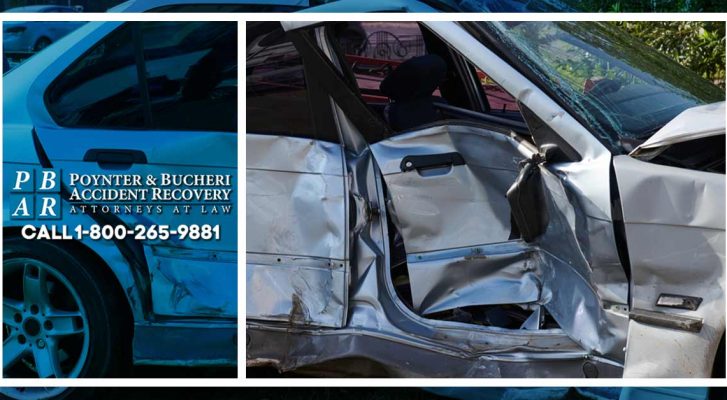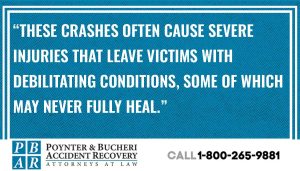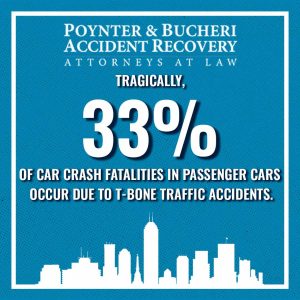
Whose Fault Is It When a Car T-Boned You?

A T-bone car accident can have serious or even fatal consequences. These crashes often cause severe injuries that leave victims with debilitating conditions, some of which may never fully heal. This leaves you wondering, whose fault is it when a car T-Boned you?

If you’ve just been in a T-bone car accident or another collision, it’s critical that you call 911 immediately to receive emergency medical attention. You or someone else caught in the accident may have suffered from life-threatening injuries, so it’s imperative to have first responders arrive on the scene and address injuries.
In the event that you experienced a recent T-bone car crash, you may wonder who is at fault. This question is especially important if you’ve suffered from injuries. T-bone injuries can leave you with costly medical bills, and you may struggle to work while you recover. Additionally, crashes can cause victims to endure permanent disabilities.
Because T-bone car accident victims often suffer substantial financial damages, it’s crucial to file a claim or lawsuit against the at-fault driver to recover compensation. You can technically do this without the help of a personal injury lawyer, but hiring an attorney will greatly increase your likelihood of recovering the full compensation you deserve.
In this blog, you’ll learn all about T-bone collisions, including common causes, T-bone injuries, and who may be at fault. If you have additional questions regarding your accident, contact the experienced car accident attorneys at Poynter & Bucheri Accident Recovery Attorneys at Law.
You can schedule a FREE consultation with our team today by calling 1-800-265-9881 to get started with your case.
What Is a T-Bone Car Accident?
T-bone car accidents occur when one vehicle crashes into the side of another perpendicularly, resulting in a “T” shape. A T-bone is also known as a side-impact collision or broadside collision.
The driver in the striking vehicle often collides with the other driver’s door, or they may strike the passenger side, frequently causing serious injuries.
Where Do T-Bone Accidents Occur?
A T-bone accident can happen anywhere when one driver operates their vehicle perpendicular to another. For instance, if a driver loses control of their vehicle and fails to stop at a stop sign, they could T-bone an intersecting driver.
Further, a driver in one vehicle making a left turn can fail to spot an approaching vehicle that has the right of way, causing a T-bone crash.
These crashes are especially common at intersections and four-way stop signs, and many T-bone accidents happen when traffic is especially busy.
The Severity of T-Bone Car Accidents
A T-bone crash can have catastrophic consequences for the drivers and passengers of the vehicles involved, especially those within the struck vehicle. Victims have less protection in a side-impact collision because cars are often not well-equipped with side-protecting safety features.

Additionally, the impact in side-impact collisions is usually much closer to vehicle occupants. The force of the colliding vehicle is often only a foot away from the driver or passenger, and this means that the debris from the collision can easily cause lacerations and blunt force trauma.
A T-bone accident is also inherently dangerous because vehicles are typically engineered to sustain force in the front and back. Your car’s crumple zones are in the front and rear, and these zones are designed to absorb the force of impact. The sides of your car, on the other hand, are not equipped with these crumple zones, meaning you experience greater impact in a T-bone accident compared to a front or rear collision.
For these reasons, these types of crashes are more likely to cause severe and catastrophic injuries than a standard car accident. Tragically, 33% of car crash fatalities in passenger cars occur due to T-bone traffic accidents.
T-Bone Accident Injuries
A T-bone accident can result in numerous kinds of injuries. The injuries sustained may just be mild, but it’s important to still seek medical attention after a car accident even for seemingly small injuries. What may seem trivial could actually indicate a more serious condition that requires medical intervention.
Common injuries after a T-bone collision include:
- Traumatic brain injury
- Internal injuries
- Broken bones and fractures
- Burn injuries
- Whiplash and other neck injuries
- Spinal injuries
- Lacerations
- Contusions
Sadly, many T-bone car accident victims struggle to work after these incidents. They may temporarily be out of work or may suffer permanently disabling injuries, such as paralysis from a spinal injury or a cognitive impairment from a traumatic brain injury.
These impairments can make paying for medical bills all the more difficult. The condition could even reduce a victim’s quality of life.
For these reasons, it’s crucial to contact a personal injury attorney. Your attorney will help you identify what damages to seek for your accident, and they’ll fight on your behalf so that you receive the most compensation possible. You may be able to recover damages for past and future medical bills, lost wages, pain and suffering, vehicle damage, loss of future earnings, and more.
Who Is At Fault for My T-Bone Car Accident?
Drivers owe a duty of care to operate their vehicles safely on the road. They must follow all traffic laws and avoid accidents to the best of their abilities. Most T-bone accidents happen due to a driver breaching their duty of care. They break a traffic law or fail to yield the right of way, resulting in a T-bone collision.
To recover compensation for T-bone accident injuries, the other driver or another party needs to have been at fault. They breached their duty of care, which then caused the accident and your resulting injuries. You also need to provide sufficient evidence that the other party caused your T-bone accident.
Identifying T-bone accident fault is often straightforward, but there are certainly more complex cases in which determining fault is unclear.
Let’s explore different scenarios demonstrating which driver could potentially be at fault for a T-bone collision.
When Is the Other Driver at Fault When You’re T-Boned?
Picture this: you approach a four-way stop. You come to a complete stop and no one else is at the crossroads. You resume driving only to have another driver crash into the side of your vehicle. The other driver didn’t see the stop sign and failed to halt their vehicle when you had the right of way.
In this scenario, the driver who T-boned your vehicle is clearly at fault. They breached their duty of care to you by failing to yield when you had the right of way, and they broke a traffic law by running the stop sign.
If you have sufficient proof indicating they ran through the stop sign, you’ll likely be able to recover compensation for your injuries.
When Is the T-Boned Driver At Fault?
Now let’s explore a scenario in which you are at fault after being struck. Let’s say that you’re at a stop sign turning left onto a busy highway. You fail to see an oncoming vehicle in the lane closest to you. You turn in front of the approaching vehicle. The other driver slams on their brakes, but they can’t halt their vehicle in time. They T-bone your car, resulting in a devastating accident.
Even if you were injured in this scenario, you would still be at fault for the T-bone accident. The other driver had the right of way. As long as they weren’t speeding, driving while distracted, or engaging in another dangerous driving maneuver, you would likely be considered at fault.
Both Drivers Are Partially Liable for a T-Bone Accident
Liability in side-impact collisions becomes more complicated when both drivers are partially at fault. Let’s say that you make a left turn at an intersection with a green light. Though the light is green, you don’t have a green light left turn signal, meaning that cars in the opposite lane of the traffic light have the right of way.
While making the left turn at the green light, you don’t see an approaching vehicle that’s speeding. The driver is also texting at the wheel. Both of your actions result in a T-bone accident. You were at fault because the other vehicle had the right of way, but the other driver was also partially at fault. They could have mitigated the collision’s damage or avoided it entirely if they had reduced their speed and stayed off their phone.
Indiana Modified Comparative Negligence
When more than one driver is at fault, insurance companies will likely consider Indiana’s modified comparative negligence system. Comparative negligence means that your percentage of liability directly impacts the compensation you can recover for damages.
Let’s say that in the previous example, both you and the speeding driver are considered 50% liable. If you file a claim to receive compensation for medical treatment and lost wages, your total recompense will be 50% less than if the other driver was solely liable. If you were considered only 25% liable, your total compensation would only be 25% less.
When it comes to a modified comparative negligence system, you cannot recover compensation if you’re considered more than 51% liable.
Comparative negligence is tricky. An at-fault driver’s insurance company could argue that you were partially liable for a car accident even if you weren’t.
If you’re blamed for a collision that you didn’t cause, you should contact an experienced car accident attorney immediately.
Common Causes of T-Bone Car Accidents
A T-bone accident can happen due to many reasons.
Some of the most common causes of T-bone car accidents include:
- Running a red light or stop sign
- Speeding while approaching an intersection or four-way stop
- Reckless and aggressive driving
- Making a left turn when you don’t have the right of way
Other factors may contribute to or cause a driver to crash into another vehicle.
These include:
- Distracted driving: Driving while texting or engaging in another distraction can cause a driver to overlook a turn signal, or they may fail to stop for oncoming traffic that has the right of way.
- Driving under the influence: Driving while impaired by drugs or alcohol is incredibly dangerous and may cause a T-bone accident. Alcohol and drugs can negatively impact a driver’s ability to notice traffic lights and oncoming traffic, and it be detrimental to their ability to make split decisions.
- Fatigued driving: Driving while tired can have similar effects as driving while under the influence. It can impair a driver’s ability to notice a red light and others on the road, and it negatively impacts decision-making abilities.
- Driving in a hurry: Being in a rush can cause a driver to operate their vehicle more dangerously and make riskier decisions at traffic lights. A rushed driver may pull out in front of other drivers, speed, or even drive through a red light.
What Should I Do After a T-Bone Car Accident?
If you’re involved in a car accident, you need to take quick action to ensure your safety. You should also begin to build your car accident case at the accident scene if you’re physically able.
Follow these steps after a crash:
Call 911 and the Police
The most important thing you need to do at an accident scene is protect yourself and others. If you or anyone else involved in the crash is injured, call 911. Sadly, most T-bone collisions cause injuries, so it’s incredibly important to contact emergency medical services.
If no one is injured, you should contact the police and wait for them to arrive at the scene. The police will also arrive if you call 911 for medical attention.
Once the police respond, answer their questions honestly so that they can create an accident report. You can use the official police report as evidence when building your car accident or personal injury claim.
Exchange Information
The drivers involved in car accidents should always exchange insurance and contact information if they’re physically able. Make sure to write down their name, phone number, vehicle information, and insurance information.
While collecting information, avoid discussing the accident with the other drivers involved. It’s also critical to avoid apologizing. It’s normal to want to say “sorry” out of politeness, but this simple courtesy can be used against you if the other driver’s insurance contests your claim.
Interview Eyewitnesses
If you’re physically able, speak with anyone who saw the collision take place. Their testimonies can be valuable for proving your personal injury claim. Write down what they saw, their names, and their contact information.
Take Plenty of Photos and Videos
Photographic and video evidence can serve as important pieces of evidence for building your case. Make sure to take many photos and videos of the car wreckage. You should also record any elements that may have contributed to the crash. These components could include the weather and road conditions. If the accident occurred at an intersection or four-way stop, ensure you photograph the signage and signals.
Get in Touch with a Car Accident Lawyer
An experienced car accident lawyer will be invaluable in helping you recover compensation. These attorneys have expertise in handling T-bone accident cases. They’ll help you collect evidence and seek the appropriate damages. An attorney can also help you by dealing with all communication with the other driver’s insurance company, and they’ll present your case on your behalf.
Contact an Indianapolis T-Bone Car Accident Attorney
Proving fault after a T-bone collision can be challenging. Fortunately, you don’t need to deal with your T-bone accident case alone. Here at Poynter & Bucheri, we have many years of experience handling car accident cases.
We’ll help you build your case and present evidence on your behalf so that you can maximize your chances of proving a successful car accident claim.
With our attorneys at your side, you’ll greatly increase the chances of obtaining a lucrative T-bone accident settlement that compensates you for your vehicle damage, medical treatment, lost wages, loss of future earnings, pain and suffering, and more.
You can schedule a FREE consultation with our lawyers today online or by calling 1-800-265-9881.
